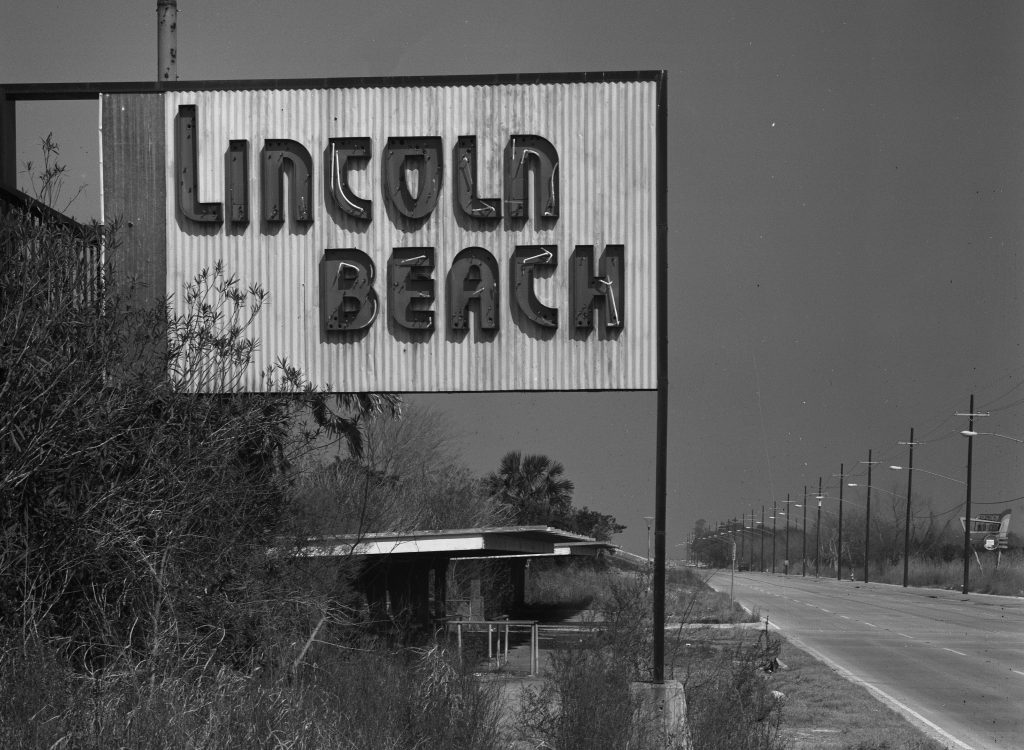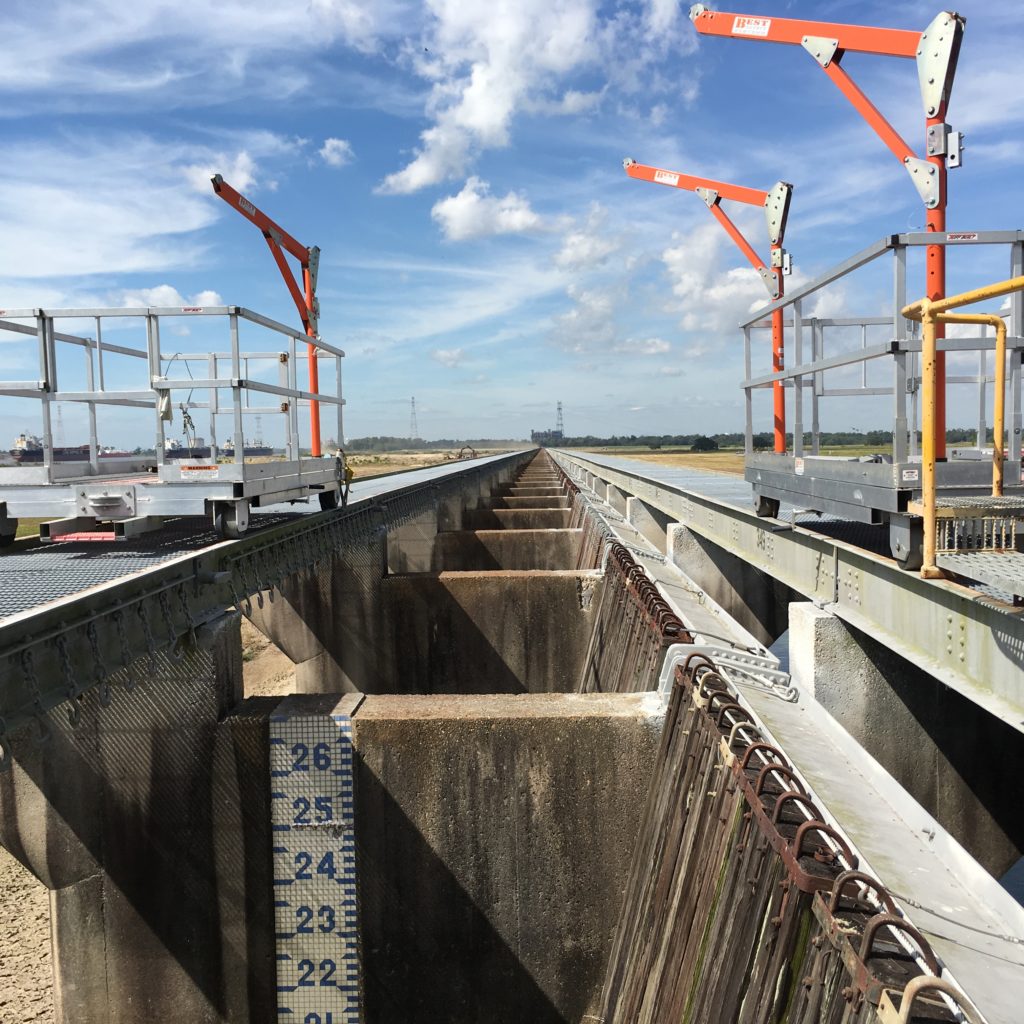Systemic racism pervades the very air we breathe, the water we drink, and the land we inhabit. We’ve created two separate rides that explore the theme, and the damage that environmental racism causes. One ride is within the city of New Orleans; the other travels upriver and explores the fence-line communities of Cancer Alley.
Route A: New Orleans East and Desire
Turn by turn directions can be found here: https://goo.gl/maps/Bw34Lt9FC9Qf9oyEA
Stop 1: Milneburg Lighthouse
This area and its surrounding neighborhoods continue to be some of the wealthiest in the city.
Stop 2: Lincoln Beach
In 1953, the New Orleans Levee Board committed to building a new park at Lincoln Beach, which the city assured residents would be better equipped than the original 1939 site. Once completed, though, the new park was still smaller and viewed as inferior compared to Pontchartrain Beach. After desegregation in 1964, attendance at Lincoln Beach declined rapidly, and eventually the park closed the following year. Although there have been various proposals to redevelop the Lincoln Beach area, the decaying ruins of the park have remained vacant for decades. The city of New Orleans has recently begun to consider efforts to clean-up and re-open the area, and so this is a space whose future is very much an open question.

Stop 3: Gordon Plaza
Today, Gordon Plaza residents are demanding that the city of New Orleans fully fund their relocation, pointing to well-documented problems with pollution at the site, despite a contentious (and seemingly ineffective) 1997 EPA clean-up effort. Residents say the lethal environment has caused buildings to be permanently shut down, minor illnesses, and terminal health issues. An April report from the Louisiana Tumor Registry found that Gordon Plaza and the surrounding Desire neighborhood had the second highest cancer rates in Louisiana from 2005-2015. Supported by the New Orleans Peoples Assembly, Gordon Plaza residents continue to fight for a fully funded relocation of their homes. Mayor Cantrell has communicated her willingness to finding a “solution” for residents, but the city has yet to commit to concrete actions. This struggle is ongoing; learn more at the online exhibition “The American Dream Denied,” or visit www.peoplesassemblyneworleans.org/gordon-plaza.
Stop 4: Desire Neighborhood
In August 1970, Mayor Moon Landrieu sent his “special assistant” Robert H. Tucker, Jr. to spend seventy-two hours in the Desire Projects, and to report on the living conditions there. Tucker’s report was clear: “Life in any multi-family structure for the low income family is a very difficult proposition to say the least. The Desire housing project is a classic study of the worst,” he wrote, describing children wading through clogged sewers, families frightened by robberies and assaults, garbage that went uncollected for days or weeks, and an explosive atmosphere of isolation and poverty. (Tucker, who grew up in New Orleans, came to the Landrieu administration as an activist, having participated in lunch counter sit-ins while attending college in Atlanta, helped integrate the National Park Service as one of the first Black park rangers, and eventually returned to his home town). After Tucker’s report, the Desire became known as one of the worst public housing projects ever put into place. Living conditions continued to deteriorate, until the city finally began the process of tearing down Desire in 1995.
Despite its reputation, it is important to remember that Desire was also a largely self-contained community, filled with thousands of people and their rich, textured lives. Reflecting on the neighborhood where he grew up, former resident Dan Perkins told WWNO, “We made fun. We found pleasure. You know we were determined to have a desire to be where we were. We had no other choice. And we made our own pleasure and you know we found out that we were human just like like everybody else. They always say no good thing came outta this project, but they were wrong.”
In 1970, the Black Panther Party established a New Orleans headquarters in the Desire Projects, quickly setting up a variety of social programs such as meal & health assistance, political education, and self defense classes to assist the residents of Desire. Throughout 1970, with the love and support of the community, the Panthers would survive an eviction, and then a September 15th shoot-out with local, state, and federal law enforcement agents. As a result of the shoot-out, a dozen Panthers were charged with the attempted murder of five New Orleans police officers, but in August 1971 a jury acquitted the Panthers after only a half hour of deliberation. Shortly after the verdict, both of the Panther headquarters in the neighborhood were “mysteriously” burned down by “parties unknown.”

Route B: Audubon Park to the Spillway
Turn by turn directions can be found here: https://goo.gl/maps/z1iRnGy85k4RtxbGA
Stop 1: Shell Norco & the Diamond community
Neighborhoods that are immediately adjacent to industrial plants, and are directly affected by the noise, odors, chemical emissions, and operations of those plants exist all along an 85 mile stretch of the Mississippi River between New Orleans and Baton Rouge, also known as Cancer Alley. The Louisiana Bucket Brigade continues to advocate for the residents of these “fence-line” communities. For twenty years, they have provided technical support in the areas of media, air monitoring, organizing, cartography, accident research, and report writing. Visit https://labucketbrigade.org/ to learn more.
Stop 2: Kugler and Kenner Cemeteries
Read more about the cemeteries in Robin McDowell’s piece for Antigravity, “Sacred Ground: Unearthing Buried History at the Bonnet Carré Spillway.”


While you are riding, bring masks and hand sanitizer, respect physical distancing, and make sure that you have an emergency contact who knows where you are and can pick you up if needed. We also have some more in-depth tips for safe biking in the pandemic, check them out! Please be aware that NOLA to Angola cannot provide logistical or emergency support to individual riders this year. Take care, and safe riding!
